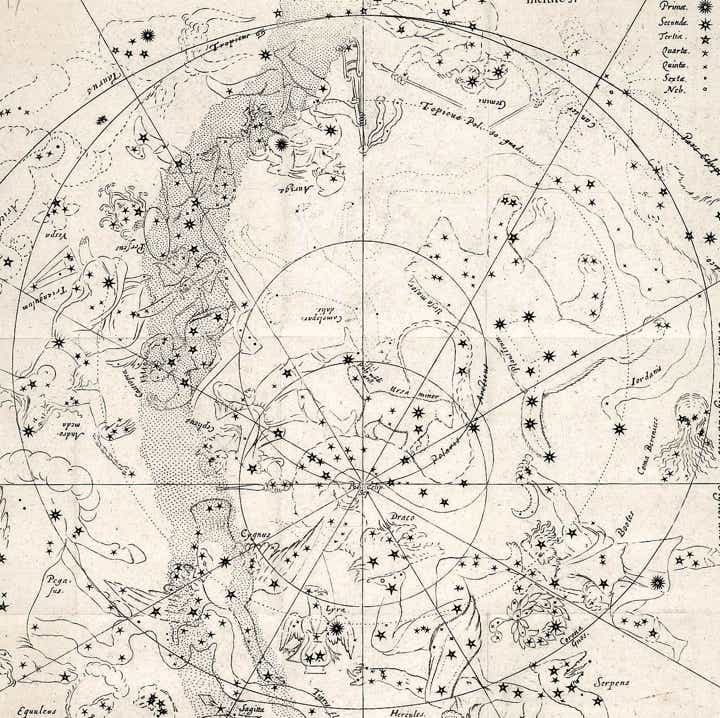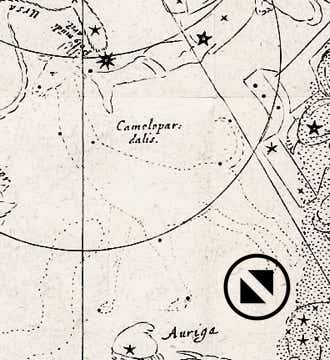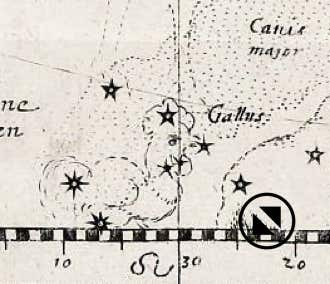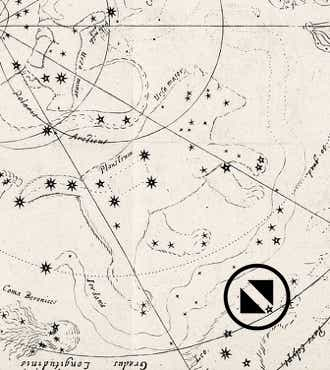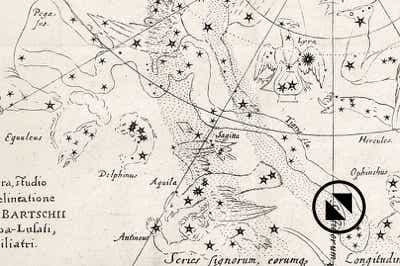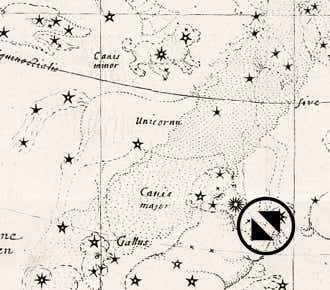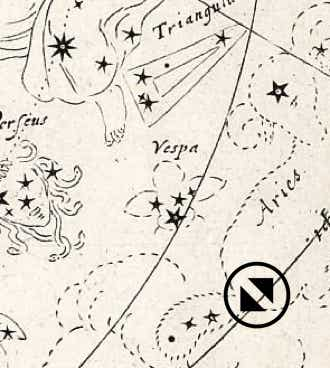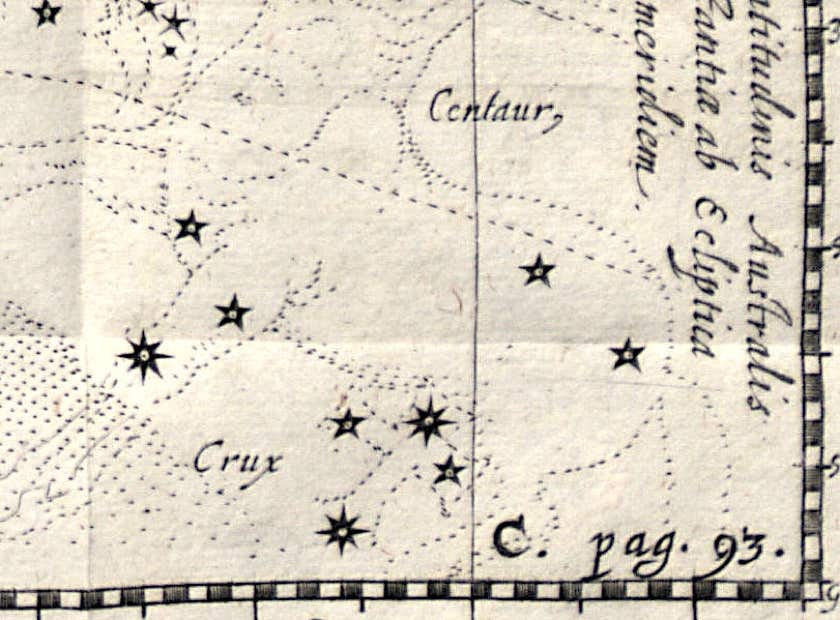Jacob Bartsch
and seven new constellations
JACOB BARTSCH (c.1600–33), German mathematician, astronomer, and brother-in-law of the great Johannes Kepler, played an often-overlooked role in the story of the modern constellations.
Bartsch’s book Usus Astronomicus Planisphaerii Stellati (‘Astronomical Use of the Stellar Planisphere’), published in 1624, introduced six new constellations invented by Petrus Plancius to a wider audience, much as Johann Bayer’s Uranometria had done for the 12 southern constellations of Keyser and de Houtman two decades earlier. In both cases, the novel constellations had first appeared on globes, which inevitably had only a limited circulation. Printed charts could be produced in far greater numbers than globes and hence were more widely seen. As a result Bartsch, like Bayer before him, was often incorrectly credited with inventing the new constellations he depicted. In reality, neither Bayer nor Bartsch invented any constellations; they simply transmitted the inventions of others to a wider audience.
Bartsch’s book (really a manual of practical astronomy) included three fold-out star charts: a north polar planisphere (left) and two equatorial strips extending to declination 55° south. There was no south polar chart. According to the Smithsonian historian Deborah Jean Warner in her book The Sky Explored, Bartsch plotted 1,111 stars on his charts, about two-thirds the number on Bayer’s much larger atlas.
Unfamiliar figures
Nestling among the traditional Ptolemaic constellations on the charts of Usus Astronomicus were six figures that would have been unfamiliar to most readers: Camelopardalis, Jordanis, Tigris, and Vespa on the north polar chart; and Unicornu (= Monoceros) and Gallus on the first equatorial chart. The second equatorial chart contained the first printed depiction of Crux as a separate constellation, but it had already been seen on Bayer’s atlas as part of Centaurus and so was not truly new. Bartsch briefly described these novel constellations in the book’s text, in which he also mentioned a seventh new constellation, Rhombus, which was too far south to appear on his charts; it lay where Reticulum is now to be found.
Apart from Rhombus, all these new constellations had been invented in 1612 by Petrus Plancius and were first shown by him on a globe of that year. Bartsch, however, did not know this. He first saw them on a globe of 1621 by the German mathematician and astronomer Isaac Habrecht II (1589–1633) and understandably assumed that Habrecht had invented them all. (He was at least right about Rhombus.) Many others in turn, encountering these constellations for the first time on the charts in Usus Astronomicus, attributed them to Bartsch. This misunderstanding persisted down to R. H. Allen’s monumental book Star Names in 1899.
Four years after Bartsch’s book appeared, Isaac Habrecht published his own printed versions of the seven new constellations in Planiglobium coeleste et terrestre (1628).
All but two of these inventions were doomed to oblivion, though. The two that survived were Camelopardalis and Monoceros. The Polish astronomer Johannes Hevelius adopted them both in his influential Firmamentum Sobiescianum star atlas and its associated catalogue published in 1690, thereby ensuring their permanence.
A third constellation almost made it, albeit in modified form: Bartsch’s Vespa, the wasp, which Plancius and Habrecht had called Apes, the bee. Hevelius renamed it Musca, the fly, and showed it on his atlas. The name was later modified to Musca Borealis, to distinguish it from the southern Musca, but it eventually followed Gallus, Jordanis, Tigris, and Rhombus into disuse.
The second edition
An expanded version of Bartsch’s book was published in 1661, well after his death, under the amended title Planisphaerium Stellati. It was edited by Andreas Goldmayer (c.1603–64), a German calendar-maker and astrologer. For this edition the type was reset and the charts revised with additional labelling. Under Goldmayer’s editorship the text was amplified with several new sections, including an all-sky catalogue of 1,230 stars, Stellarum Inerrantium Praecipuarium. This was a precessed version of the catalogue in the famous Rudolphine Tables of 1627 which had appeared three years after the first edition of Bartsch’s book.
It is the charts from the 1661 edition that are most commonly reproduced, and are the ones used on this page. The main difference is that constellation names were added to the charts on the 1661 edition. For scans of the very rare original charts from 1624, see here.
Bartsch’s charts of 1624 included the first printed depictions of Camelopardalis and Monoceros. This image of the north polar region is from the 1661 edition.
The six new constellations of Plancius shown by Bartsch
Click on a thumbnail for an enlargement
The giraffe was little more than a shadowy outline on Bartsch’s north polar chart, dotted with only a handful of stars. Isaac Habrecht’s depiction of 1628 was a lot more assured, although he omitted to label it.
The cockerel peeked just above the southern border of Bartsch’s equatorial chart, next to the tail of Canis Major and dangerously close to the hooves of Monoceros (labelled Unicornu by Bartsch). Most of Plancius’s other inventions filled gaps between existing constellations, but Gallus used stars from the stern of Argo Navis. Its stars are now part of Puppis.
In the text of his book Bartsch described this constellation as having twin headwaters called Ior and Dan, but he did not show it that way on his chart. Instead, his version started at a single source, the star we now know as Cor Caroli in Canes Venatici. The river dried up as it approached Camelopardalis, an area where Hevelius later placed one of his own inventions, Lynx.
Another celestial river that, like Jordanis, did not flow for long. Starting at the neck of Pegasus, it meandered between Cygnus and Aquila, ending in the Milky way next to the right arm of Ophiuchus.
Plancius introduced this constellation under the name Monoceros Unicornis on his globe of 1612, but Bartsch called it Unicornu. Isaac Habrecht reinstated the name Monoceros on his chart of 1628 and it has been that ever since.
Buzzing over the rump of Aries, this insect went through several transformations before finally being swatted. Plancius and Habrecht called it Apes, the bee. Bartsch changed its name to Vespa, the wasp, on his chart. Hevelius, though, imagined it as a fly, and renamed it Musca. The constellation lived on into the 19th century under the name Musca Borealis as a northern counterpart to the southern fly before its stars were finally returned to Aries.
© Ian Ridpath. All rights reserved
Crux was shown as a separate constellation on a chart in Jacob Bartsch’s Usus Astronomicus Planisphaerii Stellati (‘Astronomical Use of the Stellar Planisphere’), published in 1624. This image comes from the 1661 edition on which the constellations were labelled, which they were not on the original engraving.
